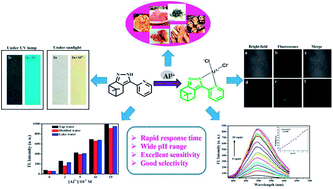A highly sensitive and selective fluorescent probe for quantitative detection of Al3+ in food, water, and living cells†
Abstract
Three novel β-pinene-based fluorescent probes 2a–2c were designed and synthesized for the selective detection of Al3+. Probe 2a showed higher fluorescence intensity toward Al3+ than the other two compounds. Probe 2a determined the concentration of Al3+ with a rapid response time (45 s), wide pH range (pH = 1–9), excellent sensitivity (LOD = 8.1 × 10−8 M) and good selectivity. The recognition mechanism of probe 2a toward Al3+ was confirmed by 1H NMR, HRMS and DFT analysis. Probe 2a was successfully used as a signal tool to quantitatively detect Al3+ in food samples and environmental water samples. Furthermore, probe 2a was successfully utilized to label intracellular Al3+, indicating its promising applications in living cells.

- This article is part of the themed collection: Editors’ collection: Fluorescent Sensors


 Please wait while we load your content...
Please wait while we load your content...